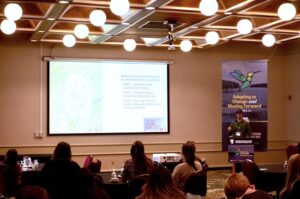Biinjitiwaabik Zaaging Anishinaabek Lake Nipigon Guardians Program featured at the Northern Ontario First Nations Environment Conference

By Rick Garrick
THUNDER BAY — The Biinjitiwaabik Zaaging Anishinaabek (BZA) Lake Nipigon Guardians Program was highlighted during the Northern Ontario First Nations Environment Conference, held Sept. 26-27 at the Valhalla Hotel and Conference Centre in Thunder Bay.
“We’re monitoring our lake, Lake Nipigon — we’re sampling fish, we’re sampling water and sediment from the Ogoki Diversion, and basically the health of the lake,” says Brendon Hardy, environmental guardian monitor and climate change champion at BZA. “I’ve been commercial fishing that lake all my life, probably 30 years of fishing on the lake with my grandfather, who’s passed now. I think he would be proud that I’m working to keep it healthy for the community. I have two children and I want them to be able to use the lake when they’re older and get the opportunities that I had.”
Hardy says his community used to be a commercial fishing village in the past, noting that he used to go winter fishing for whitefish, lake trout, and pike with his grandfather and uncle.
“We used to leave at 5 a.m. in the morning and get back at 7 or 8 o’clock at night, commercial fishing in the wintertime,” Hardy says. “It was just normal for us. Me and my grandfather were lifting nets and doing that work and we had my uncle on the side dressing the fish as we go so when we got home everything was done, [and] we just packed it.”
Tim Hollinger, Master’s student at Lakehead University’s Department of Geography and the Environment, says they have been working with BZA for about six years studying everything from fish populations to fish contaminants and lake condition history through sediment cores.
“We’ve also looked at microplastics, algae blooms in the Lake Nipigon basin, and really all areas of concern to community fishermen, community band council, and community [citizens] abroad from Rocky Bay (BZA) who have informed through traditional knowledge the research questions that we are pursuing,” Hollinger says. “Lake Nipigon has a huge history of hydroelectric dams on it and one of the common concerns when we’re looking at hydroelectric development is the rise in methyl mercury levels in fish, particularly fish that occupy high levels in the ecosystem, that eat other fish. Due to bioaccumulation, mercury biomagnifies through the food chain so fish like walleye that are commonly consumed by community [citizens] will have higher levels of mercury in them, post hydroelectric development.”
Hollinger says those impacts were not looked at in detail in the past.
“So having a community-driven and community perspective-based fish contaminants monitoring program hopefully can inspire a bit more confidence in that [and] look at which areas may have lower levels of mercury in them and be safer to consume fish from,” Hollinger says. “It’s about just getting the community involved in management practices and answering questions that they’ve observed for years.”
The Northern Ontario First Nations Environment Conference also featured two keynote presentations on Indigenous Voices Unleashed: How to Build an Online Community to Empower Climate Action by Jessica Correa, and Bear Awareness: A Personal Experience with a Predatory Black Bear by Laura Darby, as well as a variety of Waste Management, Environmental Sustainability, and Engaging Opportunities presentations.
“The conference was interesting, I’ve never been to an environmental conference but I’ve been environmental conscious my whole life through my dad,” says Wayne Sabourin, operation manager for the White Lake Limited Partnership and a former Netmizaaggamig Nishnaabeg Chief. “My dad always said that if you bring it in the bush, bring it out, don’t leave your garbage there. We have to do that, we have to look after Mother Earth because the climate is changing, rivers are drying up, people are losing their habitat, their way of life through climate, and I think we all have a responsibility in climate change.”


